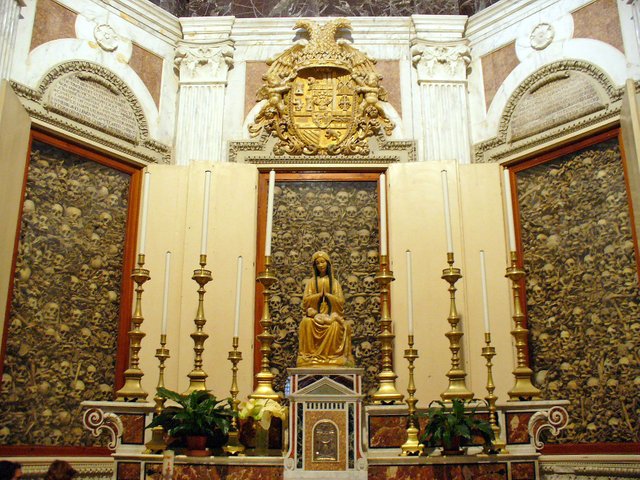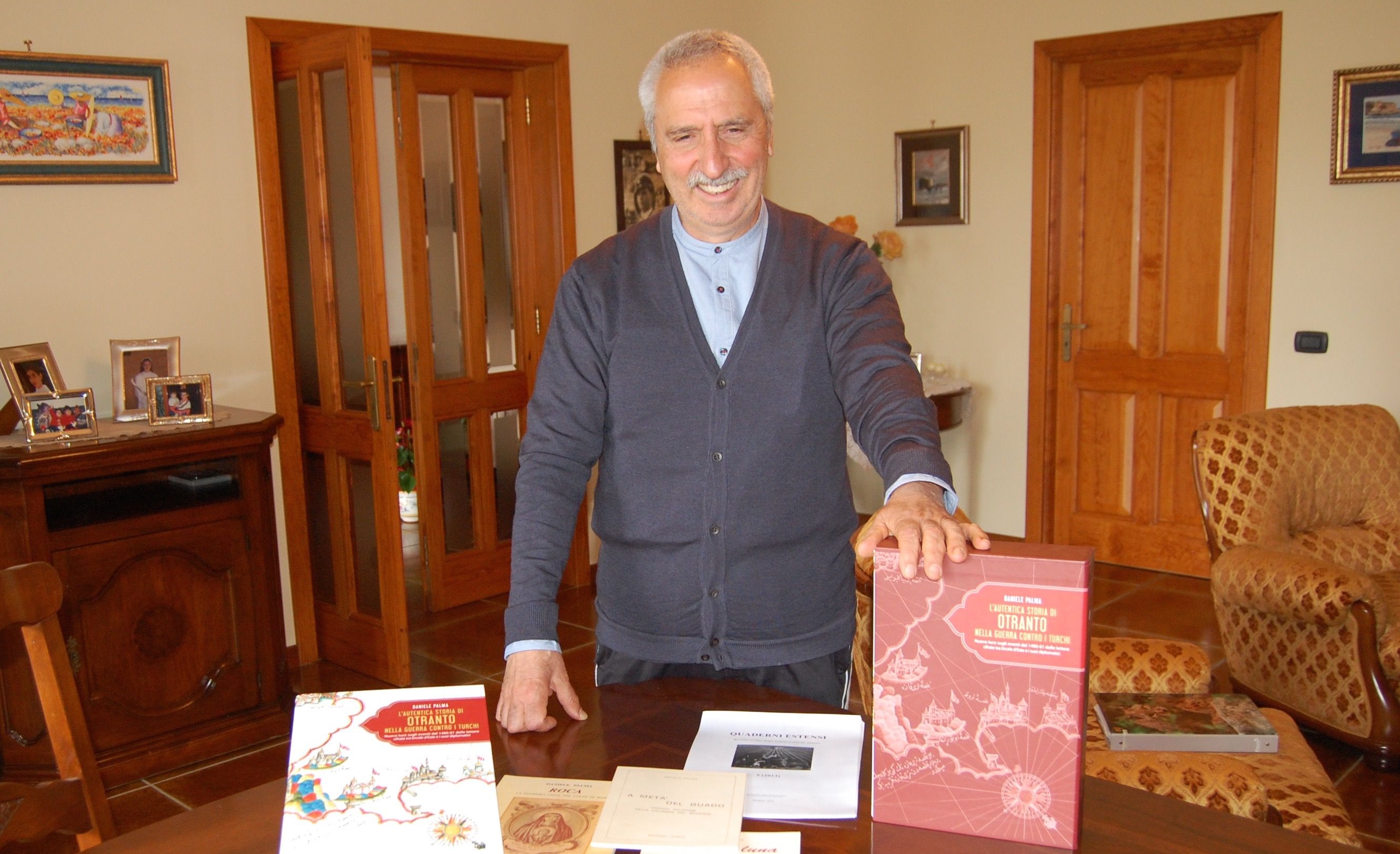
Driven by a passion for uncovering historical truths, Daniele Palma scrutinized more than 300 diplomatic letters sent during the Ottoman invasion of Italy in 1480
By Janna Brancolini
On a hill in the heel of the boot of the Italian peninsula, a fortified city overlooks the channel where the Adriatic meets the Ionian Sea. Inside the walls is a church made of a white stone with a decorative rose window façade. Like many European churches it features a main altar and a side chapel.
But in the side chapel visitors encounter something unexpected : walls of human skulls.
The skulls and other bones — which are set behind three large panels of glass — are the remains of 800 people killed during the Ottoman Invasion of Otranto during the 15th century.
In 1480 the Ottoman Turks crossed the channel and breached the walls of the fortified city of Otranto, which was part of the Kingdom of Naples at the time. As the eastern-most city in Italy, Otranto was the entry point to the peninsula for the advancing Ottoman Empire.
The Turks had conquered Constantinople 26 years earlier, and Catholic rulers feared that Rome was their next target.
During a 15-day siege in August 1480, forces led by the notorious commander Gedik Ahmed Pasha killed 12,000 people and enslaved 5,000 more, according to popular accounts. The Ottomans continued to occupy Otranto for the next 13 months, until the King of Naples succeeded in raising an army that took back the city in September 1481.
The mythos surrounding the invasion has endured in large part thanks to the bones in the church on the hill. They belonged to a group known as the “martyrs of Otranto,” 800 men who allegedly died for their faith.
According to legend, Ahmed spared 800 men during the siege of the city and gave them the choice to convert to Islam in exchange for their lives. He offered twice to let them go, free to return to their families if they became Muslims, and twice they refused.
So his men took them to a windy, sun-soaked hill outside the city walls and decapitated them one by one. Their remains were collected, the city was reclaimed in 1481, and eventually the bones were displayed in the main Cathedral of Saint Mary of Annunciation, where they can be found to this day.
For 500 years, the story of the martyrdom gripped the local and national psyche. They were beatified — or declared holy — in 1771, and in 2013 they were the first saints to be canonized by Pope Francis.
Today, the cathedral with its wall of skulls is an eerie, can’t-miss destination for visitors to the Salento region of Southern Italy.

By the early 2000s, scholars were questioning in earnest whether religion really motivated the Otranto killings. Diplomatic letters of the time didn’t mention martyrdom, the scholars pointed out.
But researchers still couldn’t answer a crucial question: Why weren’t the martyrs sold into slavery, suffering the same, more lucrative fate that for centuries befell other captives taken along the Cape of Otranto?
For want of a stronger alternate explanation, the story seemed destined to survive for another half a millennium.
Until, that is, an astrophysicist began poking around in an archive 900 kilometers north of Otranto, in the city of Modena. There he became fascinated by a trove of letters written in secret code during the invasion — and for the first time understood what likely really happened to the victims of the massacre on the hill.
Daniele Palma, 65, has a bushy grey mustache and the expression of someone always about to smile even when speaking seriously. He was born and raised in a small town about 25 km northwest of Otranto called Calimera, where he lives today.
Calimera is believed to have been founded as an ancient Greek colony in the 8th century BCE. Its name means “good morning” in Greek, and some older inhabitants still speak a dialect of Ancient Greek called Griko that until the 1700s was one of the major languages in the region.
When Palma was growing up the church kept all the local records dating back to the 1600s. He was an altar boy, and liked to read about his grandparents and great-grandparents in the church’s ledgers.
Palma attended a classical high school — the most prestigious type in 1960s Italy — where he studied Greek and Latin. But he was also interested in science and logic. After graduating a year early, he studied physics at universities in Lecce and Rome.
He finished his degree in 1975, publishing an article on globular star clusters for his thesis. From there he worked at a few different companies before settling into a career in machine logic and informatics.
“I studied physics but I never forgot my earlier education,” he explained, in Italian.
Palma returned to Calimera and, in his mid-30s, remembered the church records of his childhood. By then the city had taken over the record keeping, and he was curious if he could still read the volumes now that they were under civic control. To his delight the answer was yes.
For centuries only the church kept demographic records, but they were full of small humanizing details added by the priests.
“They would say if someone was born in an olive grove, for example,” Palma said. “I was passionate about seeing this information.”
When he had time after work he would read the records, and soon he started thinking about incorporating the information into a short book. Parts of the region’s history were missing from the official record, he thought, and these documents provided key information about the province and its people.
“History is written by the winners,” Palma explained. “In this region the Latin church had destroyed the Greek churches, burned the books. Greek culture was violently suppressed here. I wanted to offer a fuller truth.”
Local legend told of a fortress that once existed north of Otranto, called Roca, which was the site of repeated Ottoman kidnappings in the years preceding the invasion of 1480. Palma began researching Roca in 1997 and over the next five years published a trio of short books.
“I thought I would only study the war with the Turks as it related to Roca,” Palma explained. But his research uncovered more and more people and events stretching along the Salentino coast — and raised more and more questions.
“I couldn’t let go of the rest of it, so I continued,” he said.

His research led him to the state archive in Modena in north-central Italy. There he found hundreds of coded letters and other documents — such as balance sheets — related to the invasion of Otranto.
The letters belonged to the Duke of Ferrara, who in the 1480s was the son-in-law of the King of Naples. Since the duke was married to the king’s daughter, his ambassadors enjoyed unparalleled trust and access to the king.
One ambassador in particular, Niccolo Sadoletò, was even allowed to travel with the king during a seasonal pause in the fighting in the winter of 1480. His letters to the Duke were written in a mix of Italian, Neapolitan and a special coded alphabet that only he and the duke could decipher.
Palma recognized that the 300 letters in the Modena archive sent by Sadoletò and the other ambassadors were the key to understanding the real story of the war in Otranto — including the circumstances that led to the killing of the 800 martyrs.
The documents were private letters sent to the duke and served no political or propaganda purpose, he reasoned. They existed solely to relay in secret the various delicate, complicated matters of state surrounding the invasion.
“Look at this letter,” Palma said on a grey April morning, pulling a photocopied page out of a plastic covering in a binder in his home office in Calimera. “It’s written in a hurry. There are spelling errors. There wasn’t time to modify it for political or religious reasons. There isn’t a revised version that could benefit certain interests.”
By the time Palma began studying the letters, the duke’s secret code had already been cracked and some of the coded passages had been transcribed.
But Palma found so many errors in the transcriptions that he realized he would need to decode all the letters himself to be sure of the contents. His son Giuseppe also helped with the massive undertaking, and together they decoded more than 1 million symbols.
Their findings and meticulous documentation were published in a large volume, The Authentic History of Otranto in the War with the Turks, that for the first time offered a concrete explanation for the massacre on the hill following the siege of the city.
“The key word here is ‘authenticity,’” Palma said. “The sources speak.”
Congratulations @kheiromagazine! You have completed some achievement on Steemit and have been rewarded with new badge(s) :
Click on any badge to view your own Board of Honnor on SteemitBoard.
For more information about SteemitBoard, click here
If you no longer want to receive notifications, reply to this comment with the word
STOPBy upvoting this notification, you can help all Steemit users. Learn how here!
Downvoting a post can decrease pending rewards and make it less visible. Common reasons:
Submit